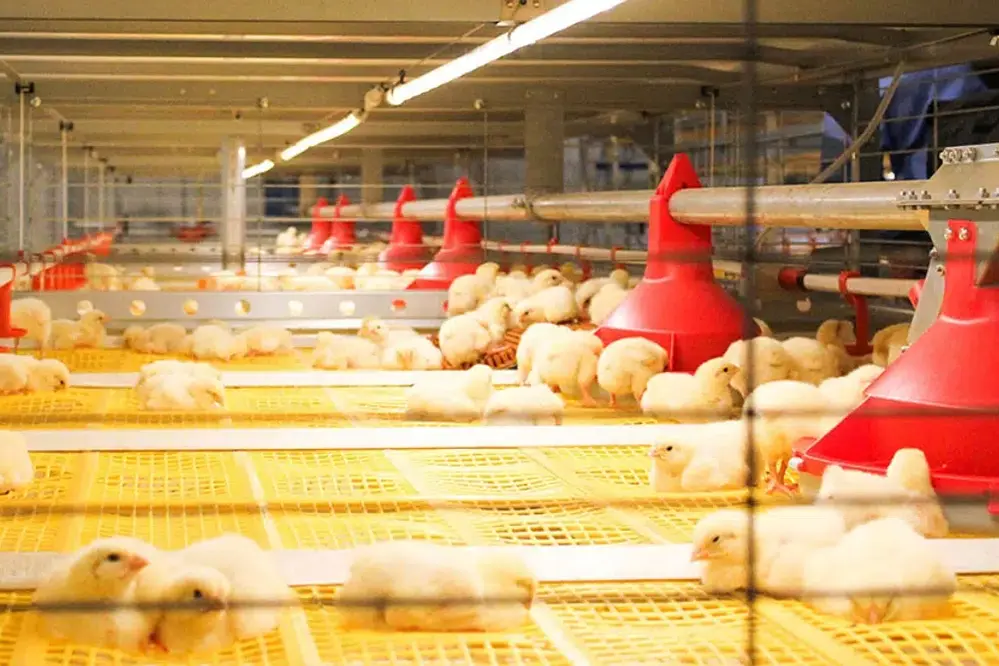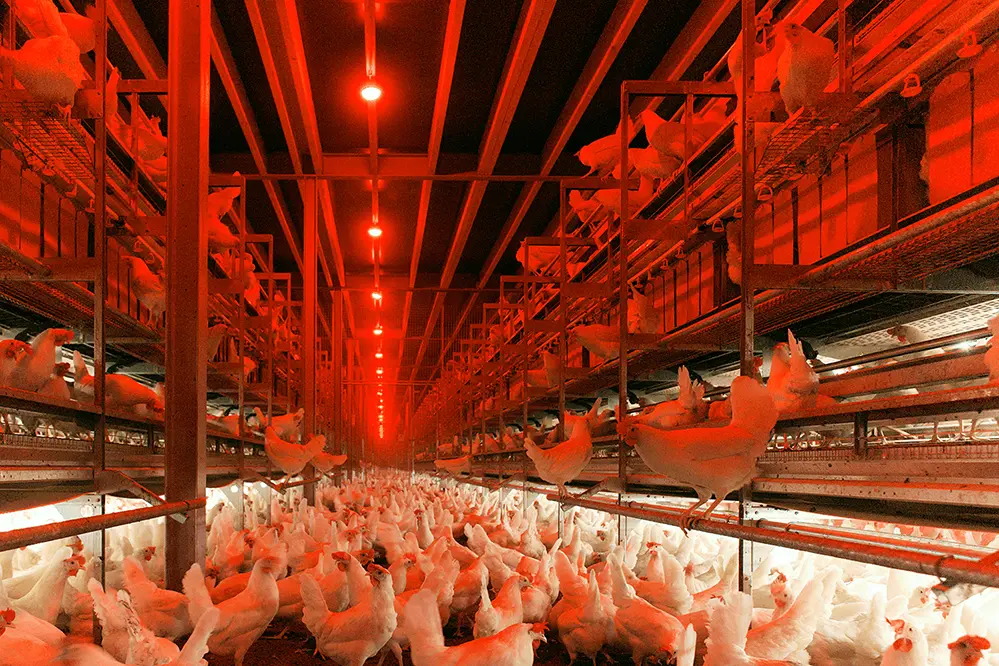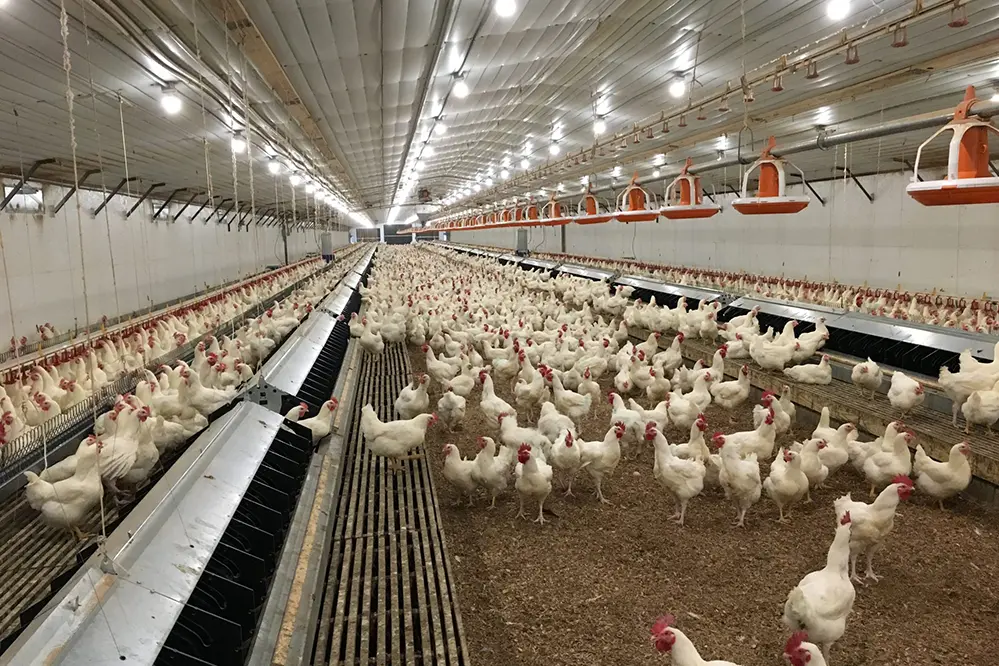In a bustling poultry farm nestled in the heart of the Midwest, a farmer named Jake discovered the transformative power of the benefits of poultry LED lighting, including the use of red light to improve flock productivity and welfare. Struggling with high energy costs and inconsistent flock productivity, Jake decided to switch to LED lighting, a decision that illuminated not just his barns but his profits as well. Within months, he witnessed a remarkable improvement in growth rates and a significant reduction in energy expenses. This story is not unique; it’s a testament to the profound impact that LED lighting can have on poultry farming.
The importance of poultry LED lighting cannot be overstated. According to recent studies, farms that adopt LED lighting can reduce energy consumption by up to 80%, a staggering statistic that underscores the economic and environmental benefits of this technology. Moreover, LED lighting has been shown to enhance bird welfare, leading to healthier flocks and improved productivity. As the agricultural industry faces increasing pressure to adopt sustainable practices, LED lighting emerges as a beacon of innovation and efficiency.
As you delve into this article, you’ll discover how poultry LED lighting can revolutionize your farming operations. From energy savings to enhanced animal welfare, the benefits are manifold and compelling. Join us as we explore the illuminating path to increased profits and sustainable farming practices.
Understanding Poultry LED Lighting

Poultry LED lighting encompasses specialized lighting systems tailored to meet the unique needs of poultry farming. Designed with precision, it provides an ideal spectrum and intensity of light.
These specialized lights cater to the natural cycles, simulating an optimal habitat for poultry.
Unlike conventional lighting, LEDs offer superior efficiency and longevity, amalgamating economic savings with environmental benefits.
Adaptable, LEDs stand out by enhancing bird welfare and productivity, contributing positively to the agricultural sector.
This lighting solution helps in managing circadian rhythms for enhanced growth and healthier poultry. Research indicates improved egg production and feed conversion ratios, propelling farm profits.
Ultimately, the use of poultry LED lighting is a strategy for modern farms striving to excel. It presents a sustainable path forward, ensuring that productivity and ethical standards coexist harmoniously.
Why Choose LED Over Traditional Lighting
LEDs provide unprecedented efficiency and adaptability in lighting.
Traditional lighting systems often fall short in meeting the specific needs of poultry farming. They lack the precision to mimic natural lighting conditions, which is crucial for promoting healthy growth cycles. Additionally, inefficiencies in energy consumption and shorter lifespans of conventional bulbs add to operational costs, hindering profitability. Contrarily, LEDs fill this gap by delivering optimized light quality and reducing energy expenditures over time.
LEDs offer unmatched energy savings.
The transition to LED lighting significantly reduces energy consumption by up to 80%, a remarkable feat that not only decreases utility costs but also supports a farm’s sustainability initiatives. This is crucial for farms aiming to maintain competitive in the rapidly evolving agricultural landscape.
LED technology’s rapid advancements ensure it remains a prime competitive choice. As we navigate through the new year, adopting LED lighting represents an inspiring opportunity to align economic goals with ecological responsibility, fostering a brighter, more prosperous future. This pivotal innovation supports the agricultural community’s commitment to efficiency and ecological stewardship.
The Benefits of Poultry LED Lighting
Implementing poultry LED lighting with automation, a beacon of technological advancement, yields vast benefits. Enhanced light spectra tailored for avian eyes lead to improved bird welfare, fostering optimal growth conditions. Significant energy efficiency and longevity elevate operational success, offering an illuminating path toward sustainable farming innovations.
Enhanced Growth Rates
Progress in poultry productivity is achievable—innovative LED lighting systems enhance environmental conditions critical for healthy growth and efficient nutrition utilization.
Poultry exposed to optimized LED lighting can exhibit growth rate improvements up to 20%.
With strategically tailored lighting spectra, farmers can steer their poultry into a realm of accelerated development. LEDs’ capability to simulate natural light environments thereby optimizes growth phases and boosts overall health and vitality.
Harnessing these innovative lighting technologies ensures a sustainable advantage—delivering precision and nurturing growth, LED enhancements empower poultry producers with the tools needed for future-ready farming success.
Improved Feed Conversion
Harnessing the benefits of poultry LED lighting significantly enhances feed conversion efficiency, translating into more substantial growth with less feed.
- Optimized Light Spectra: The specific wavelengths of LED lighting encourage better digestion and nutrient absorption.
- Consistent Light Intensity: Steady light levels reduce stress, promoting a stable feeding behavior.
- Day-Night Cycles Simulation: Accurately mimicking natural cycles optimizes metabolic processes for feed utilization.
Strategically designed LED systems align poultry activity with biological efficiency, maximizing feed conversion ratios.
In this transformative era of poultry farming, LED lighting illuminates a path toward economic and sustainable transformation, turning potential into reality.
Reduced Mortality Rates
Integrating poultry LED lighting into farming practices plays a vital role in decreasing mortality rates and enhancing flock health.
- Optimal Lighting Conditions: LEDs provide consistent, gentle light which reduces stress-related mortality in poultry.
- Enhanced Disease Resistance: Improved environmental conditions lead to stronger immune responses against pathogens.
- Controlled Environmental Variables: LEDs support stable climatic conditions, diminishing risks from temperature fluctuations.
These factors collectively minimize the occurrence of stress-induced complications and disease within the poultry flock.
Through this advancement, poultry farmers can witness their birds thriving, as improved vitality leads to healthier, more productive farms.
Energy Efficiency and Cost Savings
Poultry LED lighting offers exceptional efficiency benefits.
The adoption of LED technology in poultry sheds is a testament to the blend of innovation and practicality. LEDs require less energy than traditional lighting systems, leading to a notable reduction in energy expenditure. Consequently, these savings are not just theoretical; they manifest as tangible reductions in energy bills and operational costs.
Operational costs decrease significantly with LED technology.
Not only do LEDs provide impressive longevity, but they also deliver consistent brightness, negating the frequent replacements typical of older systems. This longevity spells out fewer disruptions in operations and lower maintenance expenses, compounding the overall cost savings.
As the world embraces sustainability, integrating energy-efficient solutions like poultry LED lighting becomes indispensable. This advancement is setting a benchmark for energy conservation and fiscal responsibility, empowering farmers to cultivate both economic and environmental prosperity.
Impact on Poultry Health and Welfare

Enhancing poultry health and welfare is a primary focus of the agricultural industry. The integration of LED lighting systems plays a pivotal role in this endeavor. With optimized lighting conditions, farmers observe improved behavioral patterns among birds, indicating reduced stress and enhanced well-being.
In recent years, groundbreaking studies conducted by prestigious institutions demonstrated that LED lighting is instrumental in fostering a healthier environment for poultry. The spectrum of LED light can be precisely managed to mimic natural daylight, which helps to regulate circadian rhythms and promote optimal growth and development. This control over the diurnal cycle supports better rest and activity cycles.
Moreover, LED lighting reduces the risk of disease outbreaks by minimizing the stress-induced factors that compromise immune systems. With proper lighting, the poultry sector has observed significant reductions in incidents of disease, contributing to higher survival rates and improved flock productivity. Reliable vision conditions also enable birds to interact more naturally within their environments.
The adaptability of LED systems further allows farmers to customize lighting conditions according to different age groups and the specific needs of various breeds. Such personalization is crucial for maximizing welfare outcomes. Farmers are empowered with the tools to create environments where poultry can thrive and reach their full genetic potential, subsequently elevating overall production quality.
Encapsulating these advantages, LED lighting positions itself as an indispensable ally in enhancing poultry health and welfare. This dynamic technology ushers in a new era of humane and productive farming practices.
Customizable Lighting for Optimal Conditions
Modern poultry LED lighting systems offer unprecedented flexibility due to their adjustable spectrum and intensity settings, making them highly effective for addressing the unique needs of flocks at various life stages. This level of customization not only enhances biological rhythms but also fine-tunes productivity across the flock.
Such flexible solutions ensure that each segment of the flock receives the precise conditions necessary for success. By doing so, they optimize the environment, paving the way for peak performance.
Adjusting Light Intensity
Adjusting light intensity holds significant promise for fostering optimal poultry growth and productivity. But what exactly does it involve?
In recent years, researchers discovered a profound relationship between lighting intensity and bird behavior. Adjusting these levels can influence growth rates, feed efficiency, and overall well-being, underscoring its pivotal role in poultry management.
Today, it’s no longer enough to offer birds a uniform lighting environment. Instead, fine-tuning light intensity throughout different life stages ensures that birds experience ideal conditions that promote well-being and enhance production outcomes.
Monitoring the effects of light intensity consistently allows farmers to make precise adjustments tailored to the needs of their flocks. This adaptability leads to improved growth rates, better feed conversion ratios, and enhanced animal welfare.
Ultimately, understanding and implementing optimal light intensity can revolutionize poultry farming practices in unprecedented ways.
Modulating Light Spectrum
Harnessing the power of light spectrum modulation can substantially impact poultry health and productivity.
- Enhanced Growth: Different light wavelengths can stimulate growth rates and increase feed efficiency.
- Reproductive Performance: Specific spectrums can optimize laying cycles and improve egg production quality.
- Animal Welfare: Tailored light conditions reduce stress and improve overall bird welfare.
- Energy Efficiency: LED lighting facilitates precise spectral adjustments with reduced energy consumption.
By modulating light spectrums, farmers align the lighting environment with the biological needs of their flocks.
This approach not only advances poultry management but also fosters sustainability and innovation in farming practices.
Long-Term Durability and Reliability
In the realm of poultry farming, efficiency and longevity are crucial. LED lighting solutions perfectly cater to these pivotal needs.
In recent years, numerous studies, including extensive research initiatives, examined how LEDs endure under constant operational conditions, outlasting many conventional lighting systems and ensuring reliability for continuous production cycles.
Today, it’s no longer about whether one can afford to invest in the durability of these systems, but rather how the benefits of long-lasting illumination outweigh the initial setup costs over years of operational savings.
Practitioners understand the value of lights that, instead of being a frequent headache, remain steadfast over the span of their 50,000-hour operational life, providing consistent illumination and minimizing maintenance interruptions.
Poultry LED lighting exemplifies enduring solutions, offering steadfast performance that illuminates possibilities for farmers everywhere.
Installation and Setup Considerations
Understanding the nuances of proper installation and setup is vital, ensuring an optimal balance of light distribution, energy savings, and a healthier environment for your poultry flock.
Clear positioning should be prioritized for LED fixtures to maximize the lighting’s efficiency.
Choose designs that account for the varying ceiling heights and configurations often found in poultry houses.
It’s imperative to consult with industry-specific experts who can tailor lighting solutions to your facility’s exact needs.
Effective planning must include consideration of dimming capabilities for gradual light changes, crucial to minimizing stress and enhancing poultry welfare, with results reinforcing productivity and health improvements.
Finally, the initial setup is an investment that pays dividends; meticulous installation leads to substantial, lasting results, enriching both your operational efficiency and bottom line.
Maintenance Tips for Poultry LED Systems
Regular maintenance of your poultry LED systems is crucial, offering the reassurance that comes from enhanced durability and peak performance.
First and foremost, to optimize functionality, perform a quarterly inspection, ensuring that all fixtures are free from dust and debris, which could impact light distribution. Over time, such buildup could inadvertently diminish the systems’ efficiency. Regular cleaning ensures your equipment continues to operate at its best, enhancing both light quality and energy efficiency for your poultry.
Consistently check for any flickering or dimming, as these could be early signs of electrical issues. In addressing such concerns promptly, you prevent disruptions in your lighting schedule, which is vital for maintaining your flock’s well-being and productivity.
Furthermore, maintaining an up-to-date log of any adjustments or repairs made to your LED systems allows for easy tracking of performance and troubleshooting areas. This proactive approach not only prolongs the lifespan of the lighting systems but also underscores your commitment to a high standard of care. Such dedication will invariably translate to more robust production metrics and sustainability practices.
Environmental Impact and Sustainability
The benefits of poultry LED lighting extend beyond efficiency to encompass significant environmental advantages. LEDs consume substantially less energy than traditional incandescent or fluorescent lights, reducing the overall carbon footprint of poultry operations.
In recent years, researchers demonstrated that switching to LED systems can decrease electricity usage by up to 60%, promoting energy conservation without sacrificing light quality or intensity. This energy reduction not only lowers costs but also aligns with global efforts to combat climate change.
Moreover, the durability of LED fixtures plays a crucial role in minimizing environmental impact. Their longer lifespan means fewer replacements, translating into reduced waste and less frequent manufacturing emissions. These factors contribute positively to sustainability goals in agriculture.
Embracing LED lighting technology in poultry farms is a decisive step towards a more sustainable future. The significantly reduced electrical consumption and lowered environmental footprint are inextricably linked with advancing eco-friendly agricultural practices.
By investing in LED solutions, poultry producers are not just optimizing operations; they are actively participating in the global dialogue on sustainability and climate responsibility.
Case Studies: Success Stories in Poultry Farms
How have poultry farms embraced LED lighting to revolutionize production efficiency and success in the realm of sustainable farming?
In recent years, BrightFeather Farms, a leading poultry farm in Pennsylvania, transitioned from traditional incandescent lighting to LED systems. They witnessed a dramatic reduction in energy costs and improved bird welfare, thanks to uniformly distributed lighting across their facilities.
Meanwhile, it’s not only BrightFeather that’s riding on LED lighting’s coattails. Shady Acres Poultry in Texas reported a 15% increase in egg production with enhanced lighting conditions optimized to simulate natural dawn and dusk cycles, fostering better laying patterns.
Across the Atlantic, Clover Valley Farm in Ireland found their annual electricity bills slashed by half, driven mainly by LED’s high-efficiency performance, and noticed a reduction in worker fatigue due to improved visibility and safer work environments.
These inspiring stories showcase how LED adoption fosters success, ensuring brighter prospects for the poultry industry.
Future Trends in Poultry Lighting Technology

As we look ahead, the horizon of poultry lighting technology gleams with remarkable potential. Driven by continuous innovation and a keen focus on sustainability, we are on the brink of groundbreaking advancements.
In recent years, experts anticipate that smart lighting systems incorporating AI and IoT will redefine poultry lighting. This fusion will offer real-time adjustments to lighting conditions, enhancing bird health and boosting productivity like never before.
Moreover, there is an emerging interest in integrating bio-responsive lighting. This cutting-edge method aims to align more closely with the physiological rhythms of poultry, promoting optimal growth and welfare naturally.
Advancements in energy storage and solar integration promise further to revolutionize poultry farms worldwide. Not only will this reduce operational costs, but it will also align with global sustainability goals, positioning poultry farming at the forefront of eco-friendly agriculture.
Our path forward is illuminated with promise, brimming with the potential to transform poultry farming into a more efficient, sustainable endeavor.
Conclusion
Poultry LED lighting is revolutionizing the poultry farming industry by offering a range of benefits that significantly enhance productivity and animal welfare. These advanced lighting systems are meticulously designed to replicate natural light conditions, thereby optimizing growth rates and improving feed conversion efficiency. By reducing mortality rates and fostering healthier flocks, LED lighting supports both economic and ethical farming practices, making it an essential component for modern agricultural operations.
The energy efficiency of LED lighting translates into substantial cost savings, aligning with sustainable farming initiatives. LEDs consume significantly less energy than traditional lighting systems, reducing utility costs and supporting environmental stewardship. Their customizable nature allows farmers to adjust light intensity and spectrum to meet the specific needs of different poultry life stages, enhancing health and welfare while boosting overall production quality. This adaptability ensures that poultry receive the precise conditions necessary for optimal growth and development.
Long-term durability and reliability further underscore the value of poultry LED lighting. With a lifespan that far exceeds conventional lighting systems, LEDs minimize maintenance and operational disruptions, offering a sustainable solution that enhances both efficiency and profitability. Proper installation and setup are crucial to maximizing these benefits, ensuring optimal light distribution and energy savings. By investing in LED technology, poultry farmers can achieve a harmonious balance between productivity and sustainability, paving the way for a brighter future in agriculture.





